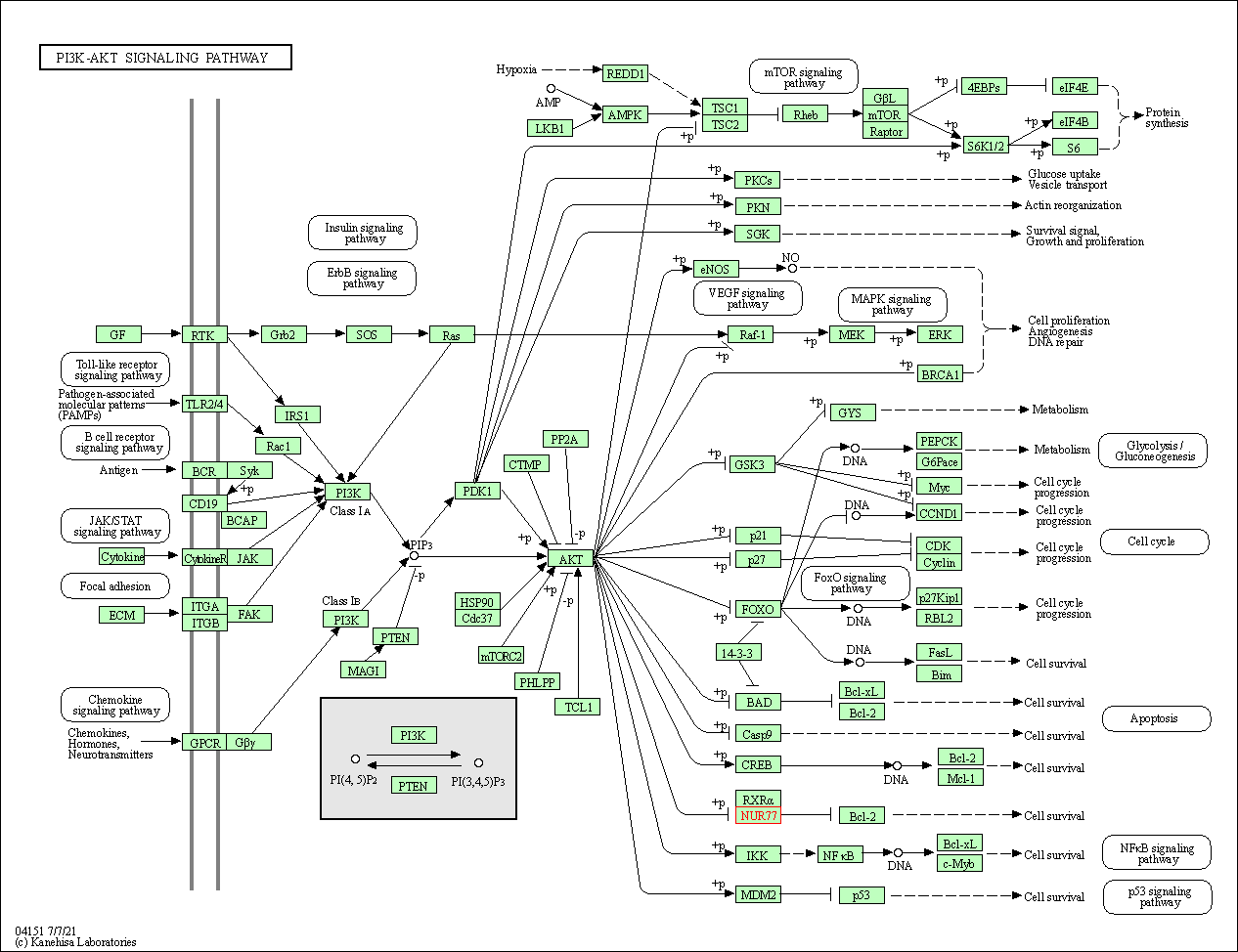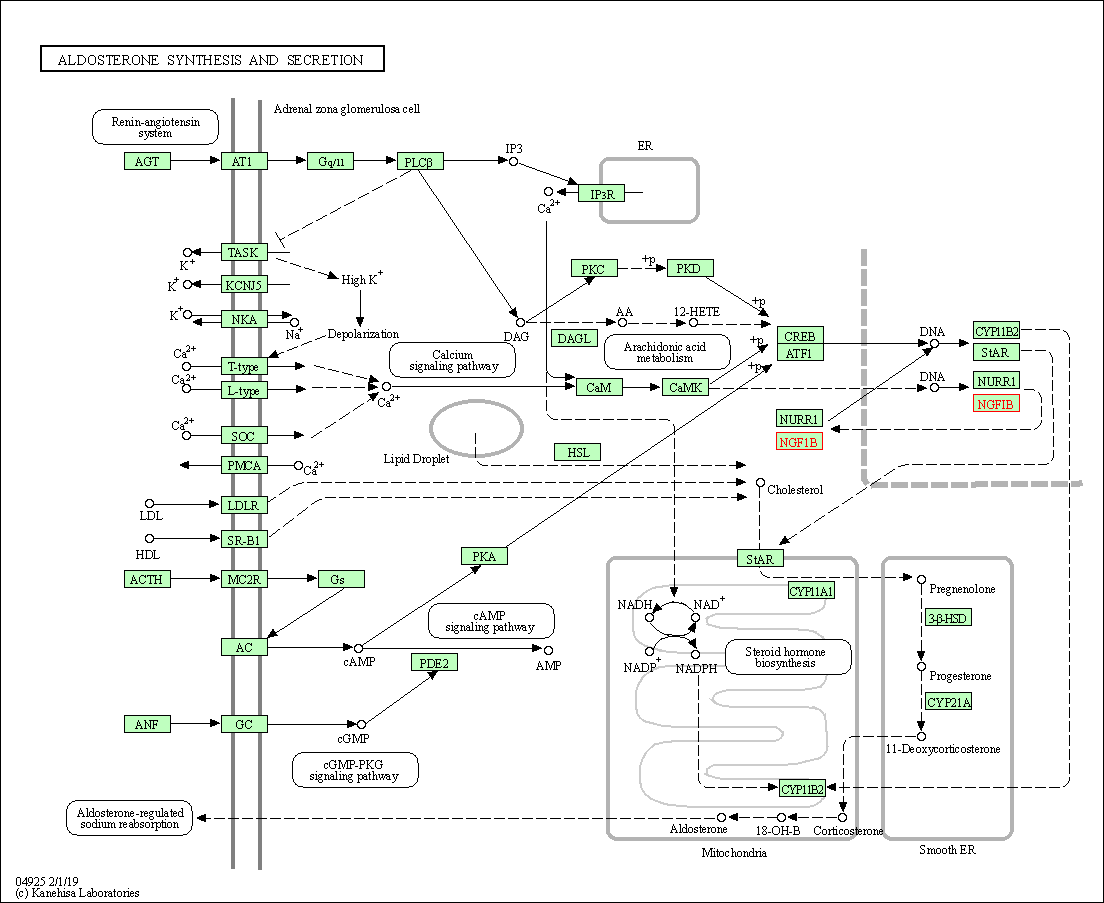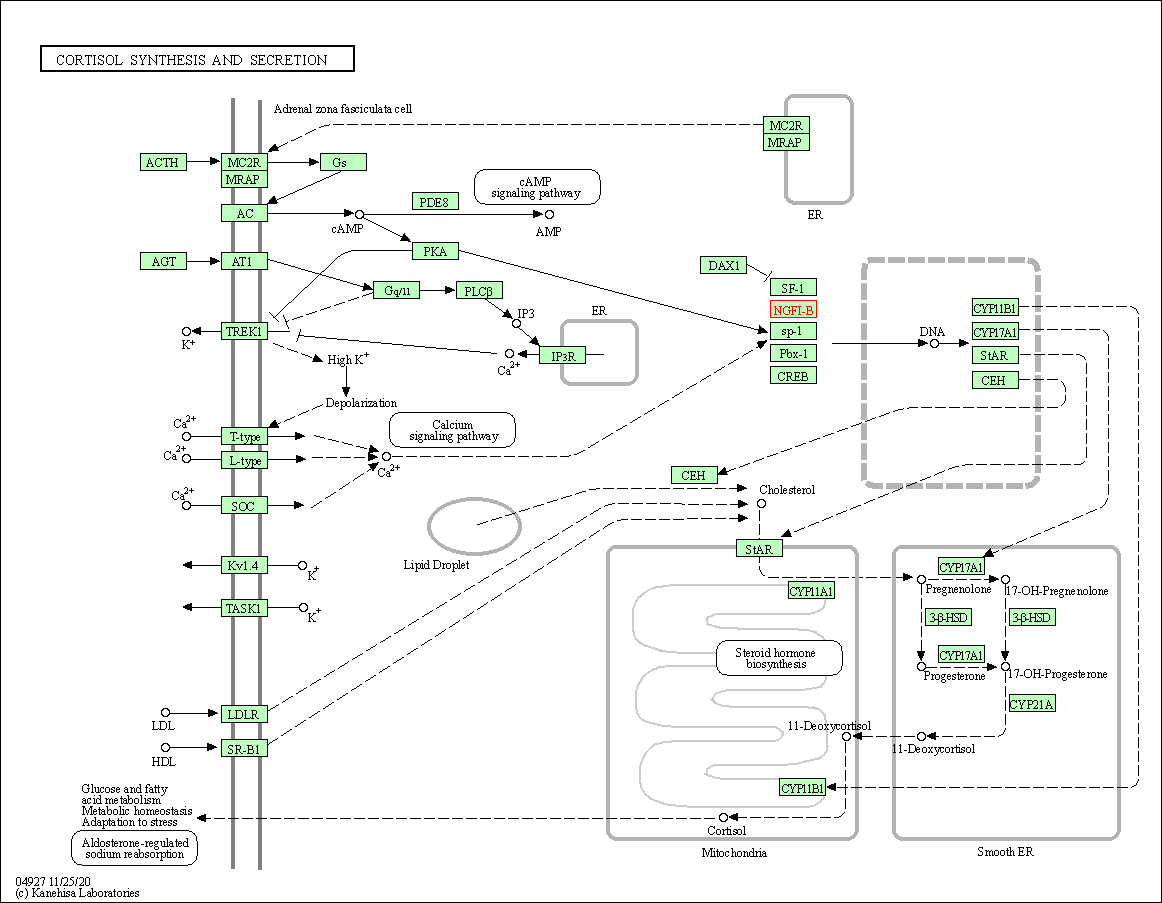Target Information
| Target General Information | Top | |||||
|---|---|---|---|---|---|---|
| Target ID |
T41119
(Former ID: TTDNR00715)
|
|||||
| Target Name |
Early response protein NAK1 (NR4A1)
|
|||||
| Synonyms |
Testicular receptor 3; ST-59; Orphan nuclear receptor TR3; Orphan nuclear receptor HMR; Nur77; Nuclear receptor subfamily 4 group A member 1; Nuclear hormone receptor NUR/77; NAK1; GFRP1
Click to Show/Hide
|
|||||
| Gene Name |
NR4A1
|
|||||
| Target Type |
Literature-reported target
|
[1] | ||||
| Function |
May act concomitantly with NURR1 in regulating the expression of delayed-early genes during liver regeneration. Binds the NGFI-B response element (NBRE) 5'-AAAAGGTCA-3'. May inhibit NF-kappa-B transactivation of IL2. Participates in energy homeostasis by sequestrating the kinase STK11 in the nucleus, thereby attenuating cytoplasmic AMPK activation. Plays a role in the vascular response to injury. Orphan nuclear receptor.
Click to Show/Hide
|
|||||
| BioChemical Class |
Nuclear hormone receptor
|
|||||
| UniProt ID | ||||||
| Sequence |
MPCIQAQYGTPAPSPGPRDHLASDPLTPEFIKPTMDLASPEAAPAAPTALPSFSTFMDGY
TGEFDTFLYQLPGTVQPCSSASSSASSTSSSSATSPASASFKFEDFQVYGCYPGPLSGPV DEALSSSGSDYYGSPCSAPSPSTPSFQPPQLSPWDGSFGHFSPSQTYEGLRAWTEQLPKA SGPPQPPAFFSFSPPTGPSPSLAQSPLKLFPSQATHQLGEGESYSMPTAFPGLAPTSPHL EGSGILDTPVTSTKARSGAPGGSEGRCAVCGDNASCQHYGVRTCEGCKGFFKRTVQKNAK YICLANKDCPVDKRRRNRCQFCRFQKCLAVGMVKEVVRTDSLKGRRGRLPSKPKQPPDAS PANLLTSLVRAHLDSGPSTAKLDYSKFQELVLPHFGKEDAGDVQQFYDLLSGSLEVIRKW AEKIPGFAELSPADQDLLLESAFLELFILRLAYRSKPGEGKLIFCSGLVLHRLQCARGFG DWIDSILAFSRSLHSLLVDVPAFACLSALVLITDRHGLQEPRRVEELQNRIASCLKEHVA AVAGEPQPASCLSRLLGKLPELRTLCTQGLQRIFYLKLEDLVPPPPIIDKIFMDTLPF Click to Show/Hide
|
|||||
| 3D Structure | Click to Show 3D Structure of This Target | AlphaFold | ||||
| HIT2.0 ID | T25C2G | |||||
| Cell-based Target Expression Variations | Top | |||||
|---|---|---|---|---|---|---|
| Cell-based Target Expression Variations | ||||||
| Drug Binding Sites of Target | Top | |||||
|---|---|---|---|---|---|---|
| Ligand Name: Ethyl (2,3,4-Trimethoxy-6-Octanoylphenyl)acetate | Ligand Info | |||||
| Structure Description | Crystal Structure of Human Nur77 Ligand-binding Domain in Complex with Ethyl 2-[2,3,4 trimethoxy-6(1-octanoyl)phenyl]acetate | PDB:3V3Q | ||||
| Method | X-ray diffraction | Resolution | 2.22 Å | Mutation | No | [2] |
| PDB Sequence |
DAPANLLTSL
37 VRAHLDSGPS47 TAKLDYSKFQ57 ELVLPHFGKE67 DAGDVQQFYD77 LLSGSLEVIR 87 KWAEKIPGFA97 ELSPADQDLL107 LESAFLELFI117 LRLAYRSKPG127 EGKLIFCSGL 137 VLHRLQCARG147 FGDWIDSILA157 FSRSLHSLLV167 DVPAFACLSA177 LVLITDRHGL 187 QEPRRVEELQ197 NRIASCLKEH207 VAAVAPASCL221 SRLLGKLPEL231 RTLCTQGLQR 241 IFYLKLEDLV251 PPPPIIDKIF261 MDTLPFL
|
|||||
|
|
HIS41
3.303
LEU42
3.409
GLY45
4.819
PRO46
2.792
LEU51
4.940
GLU109
2.853
SER110
2.855
ALA111
3.330
PHE112
3.270
LEU113
2.398
GLU114
2.644
LEU115
4.982
ARG119
4.454
TYR122
2.795
ARG123
2.658
LYS125
2.811
ILE132
4.990
LEU162
2.895
|
|||||
| Ligand Name: 1-(3,4,5-Trihydroxyphenyl)nonan-1-one | Ligand Info | |||||
| Structure Description | Crystal Structure of Human Nur77 Ligand-binding Domain in Complex with THPN | PDB:4JGV | ||||
| Method | X-ray diffraction | Resolution | 3.01 Å | Mutation | No | [3] |
| PDB Sequence |
ANLLTSLVRA
371 HLDSGPSTAK381 LDYSKFQELV391 LPHFGKEDAG401 DVQQFYDLLS411 GSLEVIRKWA 421 EKIPGFAELS431 PADQDLLLES441 AFLELFILRL451 AYRSKPGEGK461 LIFCSGLVLH 471 RLQCARGFGD481 WIDSILAFSR491 SLHSLLVDVP501 AFACLSALVL511 ITDRHGLQEP 521 RRVEELQNRI531 ASCLKEHVAA541 VAEPPALSRL555 LGKLPELRTL565 CTQGLQRIFY 575 LKLEDLVPPP585 PIIDKIFMDT595 LPF
|
|||||
|
|
||||||
| Click to View More Binding Site Information of This Target with Different Ligands | ||||||
| Different Human System Profiles of Target | Top |
|---|---|
|
Human Similarity Proteins
of target is determined by comparing the sequence similarity of all human proteins with the target based on BLAST. The similarity proteins for a target are defined as the proteins with E-value < 0.005 and outside the protein families of the target.
A target that has fewer human similarity proteins outside its family is commonly regarded to possess a greater capacity to avoid undesired interactions and thus increase the possibility of finding successful drugs
(Brief Bioinform, 21: 649-662, 2020).
Human Tissue Distribution
of target is determined from a proteomics study that quantified more than 12,000 genes across 32 normal human tissues. Tissue Specificity (TS) score was used to define the enrichment of target across tissues.
The distribution of targets among different tissues or organs need to be taken into consideration when assessing the target druggability, as it is generally accepted that the wider the target distribution, the greater the concern over potential adverse effects
(Nat Rev Drug Discov, 20: 64-81, 2021).
Human Pathway Affiliation
of target is determined by the life-essential pathways provided on KEGG database. The target-affiliated pathways were defined based on the following two criteria (a) the pathways of the studied target should be life-essential for both healthy individuals and patients, and (b) the studied target should occupy an upstream position in the pathways and therefore had the ability to regulate biological function.
Targets involved in a fewer pathways have greater likelihood to be successfully developed, while those associated with more human pathways increase the chance of undesirable interferences with other human processes
(Pharmacol Rev, 58: 259-279, 2006).
Biological Network Descriptors
of target is determined based on a human protein-protein interactions (PPI) network consisting of 9,309 proteins and 52,713 PPIs, which were with a high confidence score of ≥ 0.95 collected from STRING database.
The network properties of targets based on protein-protein interactions (PPIs) have been widely adopted for the assessment of target’s druggability. Proteins with high node degree tend to have a high impact on network function through multiple interactions, while proteins with high betweenness centrality are regarded to be central for communication in interaction networks and regulate the flow of signaling information
(Front Pharmacol, 9, 1245, 2018;
Curr Opin Struct Biol. 44:134-142, 2017).
Human Similarity Proteins
Human Tissue Distribution
Human Pathway Affiliation
Biological Network Descriptors
|
|
|
There is no similarity protein (E value < 0.005) for this target
|
|
Note:
If a protein has TS (tissue specficity) scores at least in one tissue >= 2.5, this protein is called tissue-enriched (including tissue-enriched-but-not-specific and tissue-specific). In the plots, the vertical lines are at thresholds 2.5 and 4.
|
| KEGG Pathway | Pathway ID | Affiliated Target | Pathway Map |
|---|---|---|---|
| MAPK signaling pathway | hsa04010 | Affiliated Target |

|
| Class: Environmental Information Processing => Signal transduction | Pathway Hierarchy | ||
| PI3K-Akt signaling pathway | hsa04151 | Affiliated Target |

|
| Class: Environmental Information Processing => Signal transduction | Pathway Hierarchy | ||
| Aldosterone synthesis and secretion | hsa04925 | Affiliated Target |

|
| Class: Organismal Systems => Endocrine system | Pathway Hierarchy | ||
| Cortisol synthesis and secretion | hsa04927 | Affiliated Target |

|
| Class: Organismal Systems => Endocrine system | Pathway Hierarchy | ||
| Degree | 4 | Degree centrality | 4.30E-04 | Betweenness centrality | 6.53E-06 |
|---|---|---|---|---|---|
| Closeness centrality | 2.37E-01 | Radiality | 1.42E+01 | Clustering coefficient | 3.33E-01 |
| Neighborhood connectivity | 9.13E+01 | Topological coefficient | 2.93E-01 | Eccentricity | 11 |
| Download | Click to Download the Full PPI Network of This Target | ||||
| Target Regulators | Top | |||||
|---|---|---|---|---|---|---|
| Target-interacting Proteins | ||||||
| References | Top | |||||
|---|---|---|---|---|---|---|
| REF 1 | Estrogen signaling increases nuclear receptor subfamily 4 group A member 1 expression and energy production in skeletal muscle cells. Endocr J. 2018 Dec 28;65(12):1209-1218. | |||||
| REF 2 | The orphan nuclear receptor Nur77 regulates LKB1 localization and activates AMPK. Nat Chem Biol. 2012 Nov;8(11):897-904. | |||||
| REF 3 | Orphan nuclear receptor TR3 acts in autophagic cell death via mitochondrial signaling pathway. Nat Chem Biol. 2014 Feb;10(2):133-40. | |||||
If You Find Any Error in Data or Bug in Web Service, Please Kindly Report It to Dr. Zhou and Dr. Zhang.

